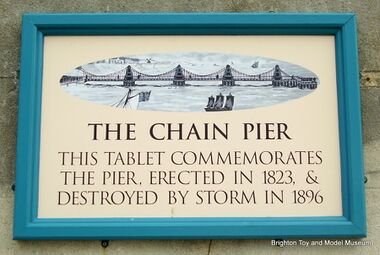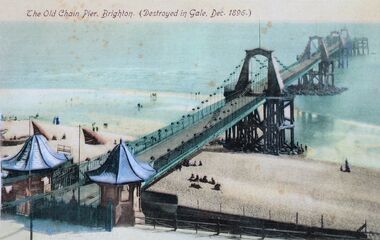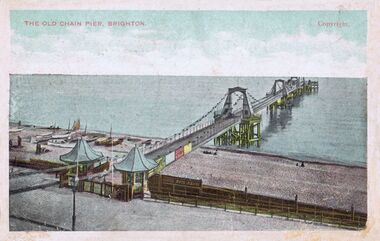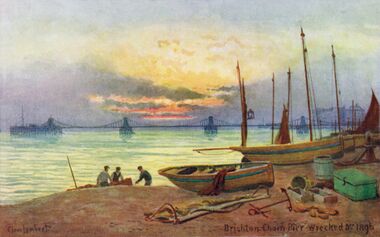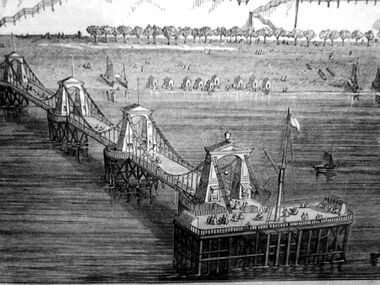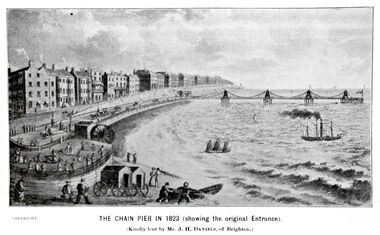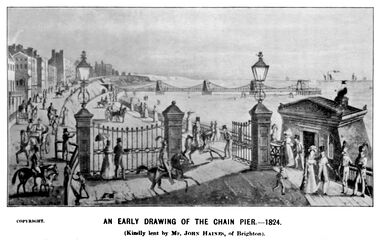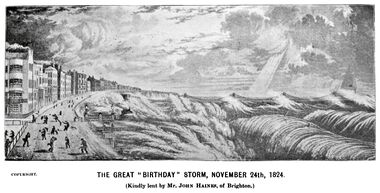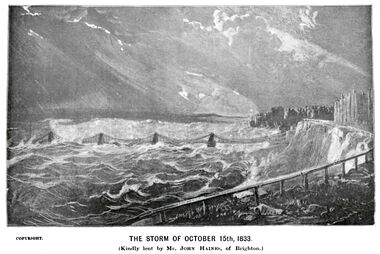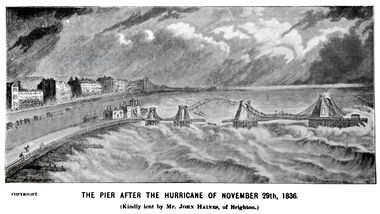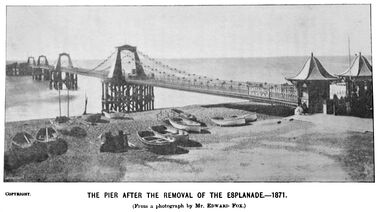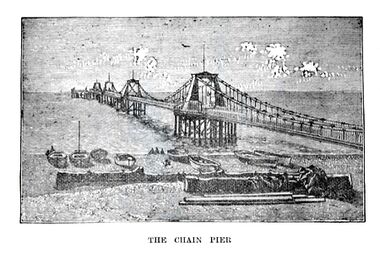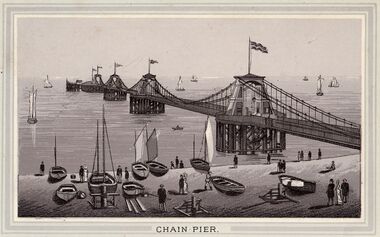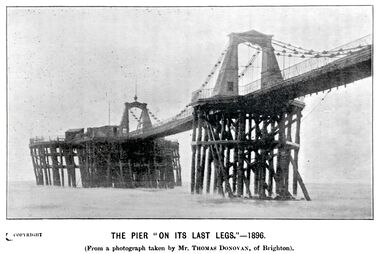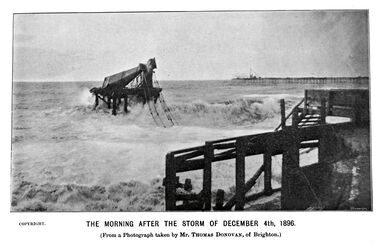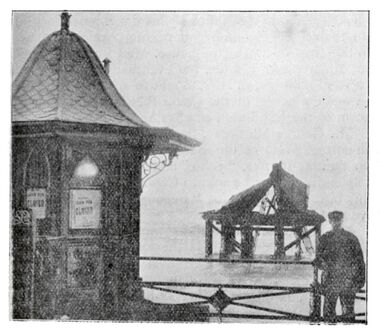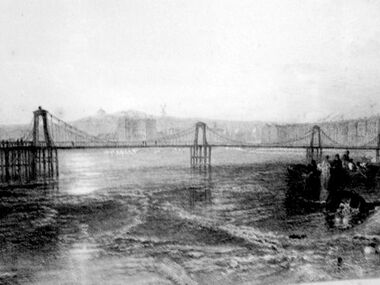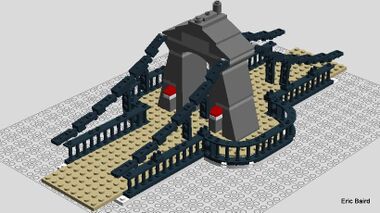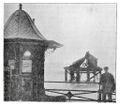Category:Chain Pier
2010 replacement plaque marking the location where the Chain Pier used to meet the shoreline [image info]
"The Old Chain Pier, Brighton", postcard [image info]
"The Old Chain Pier, Brighton", postcard [image info]
Brighton Chain Pier, by Template:Clem Lambert [image info]
Unidentified partial image of an engraving, showing the Chain Pier (and not much on the waterfront) [image info]
1823: The Chain Pier, showing original entrance and Esplanade [image info]
1824: Chain Pier entrance and Esplanade [image info]
1824: The Great Birthday Storm [image info]
1833: The Storm of October 15th [image info]
1836: The Hurricane of 29th November [image info]
1871: Chain Pier after the removal of the Esplanade, Snellings Bazaar [image info]
"The Chain Pier", engraving from the Nash Guide to Brighton 1885 [image info]
1888 engraving [image info]
1896: The Chain Pier on its last legs [image info]
1896: The morning after the storm [image info]
1896: "CHAIN PIER-CLOSED". A somewhat glum Edward Fogden, piermaster, Standing near a closed ticket kiosk [image info]
Chain Pier, Brighton, unidentified engraving [image info]
Chain Pier section, Lego Digital Designer [image info]
The Royal Suspension Chain Pier, Brighton was Brighton's first pier. It was built in 1823 and survived until 1896, when it was fatally wrecked by a storm. By this point the West Pier had also been built, and the Palace Pier (1899-) was already under construction as the Chain Pier's replacement.
Brighton Pavilion has an oil painting of Queen Victoria arriving at the Chain Pier (although the actual pier is largely obscured in the painting by shipping), and the pier was also painted by Constable.
The need for a pier
The pier was designed primarily as an embarkation point. Brighton was getting significant hotel business from people coming to the town to take the "sea cure", and the infrastructure that supported visitors was also useful to people needing an overnight stop when making the crossing to Dieppe, France – during the ten years prior to the building of the pier, the town's official population doubled.
It was becoming an increasing embarrassment to the town that the only way that people could take a ship was by hiring a local boatsman to take them from the beach to their vessel by rowboat, which created at least one awkward episode when a famous invalid on her sickbed had to be bundled up and manhandled onto the waiting boat in a very undignified manner.
Brighton was also experiencing a crisis in goods delivery by ship, especially coal. Due to the lack of suitable landing-places with good road access, ships had to unload by running aground on the beach in front of the Old Town, at which point the short stretch of seafront roadway descended into chaos. In December 1812 bad weather made landings so difficult that Brighton (not yet having a railway) actually experienced a coal shortage.
The situation clearly had to change.
Captain Samuel Brown
Marine engineer Captain Sir Samuel Brown (1776-1852) pioneered perfected and patented the use of wrought iron chain, which eventually allowed a grateful Royal Navy to replace their hemp anchor ropes with anchor chains. After retirement in 1812, Brown created a company to use the new chains to build two bridges over the Tweed (the Union Suspension Bridge survives), followed by the 650-foot-long Leith Pier (Trinity Chain Pier), completed in 1821. This left Brown and his wrought iron chain factory in Wales free to start a new project with the creation of the Brightelmston Suspension Pier Company, in 1821.
The Trinity Chain Pier allowed Brown to demonstrate that he had both the experience, and design and manufacturing ability to build Brighton a pier, having just finished building one for someone else. The Brighton version would be based on the same basic concept as the Trinity, but would be bigger, more solid and more extravagant. When the project went over-budget, Brown also made a point of putting some of his own money into the project.
Engineering and construction
The construction of the pier was something of an oddity to modern eyes, with broad clusters of wooden piles set into the beach to create a series of block "islands" terminating in the large perpendicular embarkation area. These "islands" were then given hollow cast-iron arch-shaped towers, linked with wrought-iron chains to create a sort of suspension bridge, with the chains at the seaward end being anchored to massive weights, and the chains at the landward end being set deep into the cliff's rockface, fed into deep narrow shafts that were then filled-in with rubble and cement.
Although piles were tipped with pointed iron caps, the pier relied to a certain extent on the rigidity of the islands and the sheer amount of weight bearing down on them, and the width of the end "T-piece" helped to resist it being pushed over or sideways by currents.
While the chains were made in Wales, the cast-iron buildings that supported the chains were made in Brighton at the Regent Foundry, which opened a new works site in North Laine to give them the extra manufacturing capacity required.
Egyptian influences
The design of the towers was influenced by the Egyptian Revival a craze for Egyptian monumental design that took off in the first two decades of the Nineteenth Century, after Napoleon's invasion of Egypt in 1798. Napoleon (who had originally wanted to be a scientist or explorer) took with him a team of more than a hundred and fifty academics to investigate and document Egypt's cultural legacy, with their work being published in the volumes of the Description de l'Égypt. Along with the discovery of the Rosetta Stone and the ensuing interest in uncovering the ancient history of the region, the resulting glut of engravings, drawing and paintings documenting the region was enthusiastically drawn on by designers and architects, with Percy Bysshe Shelley (1792–1822) publishing his famous poem "Ozymandias" in 1818.
Entertainment
Although the Chain Pier's primary justification was to allow a place for ships to dock, the bases of the hollow arches had small "rooms" that allowed them to house shops to service the needs of visitors, and the success of the pier and of these vending-points helped to establish the case for a dedicated "pleasure pier" in Brighton, especially after the arrival of the London-Brighton line in 1841.
Although the West Pier (1861) was then built a little further to the west, the increasing decrepitude of the Chain Pier and its obvious inadequacies as a tourist-oriented site compared to the grand ornateness of the West Pier led to the decision to build a brand new pleasure palace of a pier alongside (the current Palace Pier). The Palace Pier's company also bought the Chain Pier, the plan being to demolish it once its replacement was ready for service.
Painters
John Constable (1776-1837) first came to Brighton the year after the pier opened, in 1824. His main interest in Brighton was the hope that the climate and waters might help the health of his wife Maria Elizabeth, and he spent a fair amount of time in the town during the 1820s, during which time the scenery in Brighton and elsewhere, in Weymouth, is supposed to have encouraged him to develop a more vivid painting style. His "six-footer" painting of the Chain Pier was completed in 1827. Constable complained that there was not much for a painter to do in Brighton, since so much of the seafront was artificial, and swarming with "hideous" people ("Picadilly by the seaside").
Remnants
- The site where the Chain Pier came ashore is still visible, as the character of the sea wall changes for a section corresponding to the pier's location. The site is also marked by a plaque.
- Remains of some of the pier's oak supports are still supposed to be visible at very low tides.
- With the official demolition of the Chain Pier, the pier's two flanking kiosks were incorporated into the front of the new Palace Pier (along with the entranceway clock from the Aquarium). However, the kiosk roofs do not seem to have made it to the new location - the front of the Palace Pier has four similar structures, and the owners seem to have decided that since they were going to have to create two new roofs, they might as well make all four – while these these look very similar to the original Chain Pier kiosk roofs, the have a raised step midway, and their edges are lined with lightbulbs.
- At least one of the original kiosk roofs seemed to end up somewhat incongruously "plonked" on the top of a large shed in the corner of the Harvest Forestry recycling and reclaimed timber yard on the New England site, where it could be seen during the 1990s.
- Chain from the Chain Pier is supposed to have been buried in the roadway at the top of Trafalgar Street when the slope of the road was changed, the hope being that this would make the new sloping road surface more stable and less prone to sagging and subsidence.
Historical references
1825: Topographical Sketches of Brighthelmston and its Neighbourhood:
The CHAIN PIER, or SUSPENSION BRIDGE, which is of very recent construction, greatly increases the beauty of the Marine Parade. This curious specimen of modern ingenuity and scientific art, is connected with a fine Esplanade 1250 feet in length, and 33 feet in breadth; which, on the land side, has a bank sloping from the cliff, and on the other, is defended from the encroachments of the sea by a stone wall, surmounted by a railing, about breast high. At the termination of the Esplanade, the Chain Bridge commences, which is upon the same level as the former road, but extends from it, at right angles, more than 350 yards into the sea; its breadth, between the chains, is twelve feet. The foundation consists of four clumps of strong piles, of timber, driven into the chalk rock, to the depth of from seven to ten feet, and rising to the height of thirteen feet above high water. These clumps are at the distance of about 258 feet from each other; and each of the three first, or those which are nighest to the cliffs, is formed by twenty perpendicular piles, connected with each other by proper bracings. The fourth, or extreme clump, consists of a frame work in the form of a τ, the cross part extending ninety one feet, east and west. This is composed by one hundred piles, braced together by numerous horizontal and diagonal beams and wale pieces; and including galleries, with several flights of steps descending from them for the conveniency of embarkation or landing. Over each clump of piles rises a kind of pyramidical tower of cast iron, twenty five feet high, formed by two side towers, connected together by a transverse arch, and pediment. These support the eight suspension chains which sustain the lower frame of the Bridge, and which are of wrought iron, every chain being composed of 117 links; each link is ten feet in length, six inches and a quarter in circumference, and 112 lbs. in weight; the links are secured by bolts and strongly keyed. These chains, of which there are four on each side, are continued from their respective attachments within the cliff, over the several towers, to the outer extremity of the pier, towards which they diverge, from the last tower, in an angle of thirty seven degrees, and are locked down by properly secured bolts and keys; they have also a poising bias of about 200 tons of Purbeck stone, to act with that derived from the deep embedment of the chains in the cliff wall. The ends of the suspending rods, which are shaped like a τ, are fixed within the hollow caps that head the junction of the links where the bolts are applied. All the chains emerge from secure, but concealed, attachments beneath the cliff; which, principally, consist of two large iron plates, each weighing about one ton and a quarter: they are embedded at the extremity of excavations, fifty four feet in depth, formed like barrel drains, and filled up with stone and brick-work laid in strong cement. The platform, which is of wood, is supported by car lines, or cross timbers, resting on two bars of iron that extend the whole length of the pier, and are held by the suspension rods: the number of the latter is 362; they are of different lengths to accord with the dip of the chains, which, at the central point between the towers, is about eighteen feet. Each tower weighs about fifteen tons; they are hollow, and are intended to be fitted up for the sale of refreshments. The Bridge itself, with the stone platform at its extremity, forms a pleasant promenade: the charge for each foot-passenger is two-pence, which is taken at small toll house, at the entrance of the Esplanade.
This Bridge was projected and executed by Captain S. Brown, of the Royal Navy; under the provisions of an Act of Parliament passed in the year 1822, by which a Company was incorporated, and authorized to raise £27,000, in shares of £100 each, for the purpose of raising and upholding this ingenious structure. It is understood, however, that the expenditure has exceeded that sum by three or four thousand pounds. The work was commenced in October, 1822; and being completed in the October following, the Bridge was opened to the public in the ensuing month of November. It is intended that the Steam Packets for Dieppe, shall take in their passengers and freights from this Pier.
— , E.W. Brayley, F.S.A., , Topographical Sketches of Brighthelmston and its Neighbourhood, , 1825
1826 description:
THE ROYAL SUSPENSION CHAIN PIER
This stupendous and curious specimen of modern ingenuity and scientific art, has considerably added to the beauty and importance of the town. It affords one of the most healthy delightful walks, that can possibly be imagined. Sheltered by the Cliffs from the northerly wind, the promenaders, (of which there are on some days upwards of 4000,) may enjoy the refreshing breezes from the sea, without being inconvenienced by the clouds of dust, which are driven along the public thoroughfares. That this extensive bridge, should be able to stand against the fury of the elements is truly astonishing, when we consider the distance that it is suspended in the sea; but such is the amazing strength of the supporting chains, in connection with the weight which rests upon them, at either extremity, united with the assistance and support of the piles, it has stood one of the most tremendous storms, that ever visited this part of the coast. And although the tide was so strong, as to force up some of the boards in the flooring, and at times, completely covered the building beneath its waves, yet it received no material injury, and it may therefore be presumed, it will stand for generations to come, as a memento of the ingenuity and talents of its scientific projectors. ...
Description – Commencing at the end of a beautiful esplanade, 1250 feet in length, and 33 feet in breadth, it runs out into the sea upwards of 350 yards.
The foundation of this curious but elegant structure, consists of four clumps of piles of timber, driven eight or ten feet into the solid rock, and rising fourteen feet above high water mark. The first three clumps consist of twenty piles each; the fourth, which is in the form of a T, has 150 perpendicular and diagonal piles, strongly braced by framings, and whole pieces in various places. At the top of this clump, is a platform eighty feet long, paved with about 200 tons of Purbeck-stone, and beneath are galleries and flights of steps, for the convenience of embarkation. The groups of piles are 258 feet apart, and over each rises a kind of pyramidical tower of cast iron, twenty five feet high, formed by two side towers united by an arch. The interior of these towers, are fitted up for the sale of books, prints, and confectionary. Over the towers pass the main suspension chains, which issue from the body of the cliff, into which they are carried fifty four feet, and are fastened to an iron plate, weighing nearly three tons; thus secured, the excavations are filled up with stone and brick work. These chains after passing over the towers to the outer extremity of the Pier, diverge from the last tower in an angle of about 87 degrees, and are at the ends embedded in the solid rock, and are properly secured by bolts and keys, with the additional security of the whole weight of the platform before mentioned. Of these chains there are four on each side, composed of 117 links each; each link being ten feet long, six inches and a quarter in circumference, and weighing 112 pounds.
The Pier, or bridge, is one thousand one hundred and thirty four feet long, and thirteen feet wide, with a neat iron railing on each side, and supported by car-lines or cross-timbers, resting on two bars of iron, which extend the whole length of the Pier, and are upheld by the suspension rods, which are of different lengths, and are 362 in number. A handsome road and esplanade, 1250 feet in length, constitute the approach to this elegant structure; the whole is handsomely painted, and is the finest specimen of this kind of Architecture in the world. The esplanade, and bridge, form a pleasant promenade, the entrance to which is through toll-gates, and the demand for each foot passenger is two pence, which is paid at a small Toll-house, at the entrance of the Esplanade; another entrance to the Pier is by a steep flight of stairs from the Marine Parade, in front of the New Steyne, where there is another toll-house. The whole was projected and executed by Captain Brown, of the Royal Navy. It was estimated at an expense of £27,000, but has exceeded £30,000, which was defrayed by shares of £50 and £100.
THE CAMERA OBSCURA
At the further extremity of the Pier is a fine Camera Obscura, by Mr. Haines, which appears to answer the expectations of its proprietors, The Chain Pier Company.
At the bottom of the Pier is a fine building, occupied by Mr. Sawyer, as a Subscription Library; contiguous to which is a neat little house, in which Mr. Matthews, the Pier-Master, resides.
— , J. Whittemore, , 1826
1838: A Stranger's Guide to Brighton
CHAIN PIER
This light and elegant structure was erected after the design and under the superintendence of Capt. Brown, R.N., at an expense of £30,000. It was commenced in October, 1822, and opened to the public in the November of the ensuing year. Its length is 1134 feet, and the promenade is 13 feet wide, enclosed on each side with a neat iron railing. The four iron towers supporting the chains are erected on platforms raised on piles driven nearly 10 feet into the solid chalk rock, but rising nearly 13 feet above high-water mark. These towers are about 200 feet distant from each other. There are two double suspension chains on either side of the Pier, each double chain consisting of wrought iron rods or links, two inches in diameter, and very ingeniously connected: those at one end pass into tunnels formed in the cliff, the size of which gradually increases, and are secured to a plate of iron placed perpendicularly at the north end, much larger than the opening of the cylinder. After passing the towers mentioned above, the chains are firmly fixed to the massive timber frame work of the Pier head: the archway dividing each of the towers is 10 feet wide, and the platform which forms their base extends 12 feet on each side of the promenade. The interior of the turrets are fitted up as shops for fancy articles
The Pier head is an extensive platform raised on piles and is paved with Purbeck stone. There are several flights of steps descending to a lower platform, and to the sea; together with commodious baths in the gallery beneath.
Facing the Pier, on the south, is a building seventy feet by twenty-five, over which is the CAMERA OBSCURA.
The entrance to the Pier is by an Esplanade 416 yards in length, from the commencement at the bottom of the Old Steyne, where the toll house is situated. A second entrance is by a flight of steps descending from the cliff opposite the New Steyne.
A band is, during the summer months, occasionally stationed at the outer end of the Pier, which forms one of the most agreeable walks in the town, uniting the advantage of the purest sea air, with great beauty of situation and convenience of access. The general view of Brighton from the Pier head is magnificent; the eye catches the whole range of buildings from Brunswick Terrace to Kemp Town, while the coast beyond Beachy Head, on a clear day, may be plainly seen to the east, and the Isle of Wight as distinctly to the west. On the arrival or departure of the steam-packets, the Pier is generally crowded with fashionable company. The Pier was severely tried by a storm in November, 1824, the waves ran mountains high, and often obscured it from sight, no serious injury was sustained; but November 29th, 1836, will long be remembered by the inhabitants of this town, as the era of a hurricane which is without parallel in the recollection of the oldest inhabitant. The celebrated gale of November, 1824, (represented by the engraving) was unquestionably much inferior in the violence of the wind, but as that took place at the period of high spring tides, it produced an effect much more imposing. From 10 o'clock in the morning till about 1, it blew a perfect hurricane, fortunately it was not high water, and to this circumstance, with that of its being neap tides, we are in all probability indebted for a much less extent of damage than would otherwise have been the case. The power of the wind exceeded almost belief. Numbers of persons, induced by the novelty of the scene, had assembled on the Pier esplanade, at the height of the gale, about 12 o'clock, one of the centre bridges had evidently acquired a vibratory motion, which continued to increase and communicated itself to the whole structure. The iron railing gave way about half-past 12, and at a quarter to 1 the bridge was lifted up several feet, and when it fell, the iron rods by which it was suspended, snapped asunder, and the bridge fell into the boiling waters below, two persons crossed just before it gave way, had they delayed a minute they must have perished. This is the second time the Pier has suffered from the fury of the elements. On the 15th of October, 1833, much injury was sustained, supposed by some persons to have been struck by lightning. The repairs amounted to about £2000, which was in part defrayed by subscription of the visitors and inhabitants. A new protection against storm has now been introduced, which it is expected will prevent the Pier from sustaining any further injury.
The sad effects of the storm were not confined to the Pier, scarcely a house in the town escaped entirely from its violence, a great many chimneys were blown down, besides slates, tiles, &c., from the roofs of the houses, which rendered it highly dangerous to pass along the streets; a man named Leggat, passing down the New Steyne, was killed on the spot by a sheet of lead falling on him; several other serious accidents occurred during the gale.
— , Saunders, , The Stranger's Guide in Brighton; Being a Complete Companion to that Fashionable Place, and the Rides and Drives in Its Vicinity., , 1838
The Royal Chain Pier Subscription Library is particularly adapted to visitors, &c., for a short period; is supplied with magazines, reviews, and the daily and weekly papers; the subscription is upon a moderate scale. This library is on the Chain Pier Esplanade, and has an extensive sea view.
— , Saunders, , The Stranger's Guide in Brighton; Being a Complete Companion to that Fashionable Place, and the Rides and Drives in Its Vicinity., , 1838
1840: The Parliamentary Gazetteer of England and Wales, p.276
Suspension Chain-pier. } – A suspension chain-pier affords great facilities here for the landing and embarkation of passengers, as well as an agreeable promenade. This work, begun in October 1822, and carried on under the superintendence of Captain Brown, R.N., was finished in November 1823. It extends 1.014 feet into the sea from the front of the esplanade wall. The entire length is 1,136 feet, and is divided into four spans of 225 feet each. The platform is 13 feet broad. There are eight main chains, carried over pyramidal cast-iron frames, 25 feet high resting on piles; the extreme pile at the head of the pier is spread out laterally, and is covered with granite paving, weighing upwards of 200 tons, – the object being to afford a firm base for the back-stay chains which are bolted to diagonal piles constructed in the extreme pile. At the land-end the main chains are carried over a pier of masonry, and through two tunnels cut in the cliff, 30 or 40 feet deep; and secured in a brick chamber to massive stones, by means of a ponderous plate of cast iron. This beautiful pier was greatly injured, if not destroyed, by a tremendous gale, during the night of the 15th October 1833. The platform between the first and third piers was almost entirely destroyed; all the suspension-rods broken, and the main chains much deranged, while the weight of the road-way being removed, the chains over the first and fourth spans were so much depressed that the platform they supported was also greatly injured. It has been thoroughly repaired. Steam-packets sail from hence to Dieppe, a voyage of about 80 miles.
— , -, , The Parliamentary Gazetteer of England and Wales, p276, , A.Fullerton & Co., , 1840
1854: The English Cyclopaedia: A New Dictionary of Universal Knowledge, Volume 6:
The rapid increase of Brighton caused the want of a suitable landing place to be strongly felt. A company was accordingly formed for the erection of a suspension or chain pier, which was begun in October, 1822, under the direction of Captain Brown, and opened in November of the following year. The cost of erection was 30,000 l . It is composed of four spans or chain bridges, each 255 feet in length, and at the end on a framework of strong oaken piles is a platform paved with blocks of granite. The main chains, which are eight in number, are carried over pyramidal cast iron towers 25 feet high, which rest on clusters of piles. The entire length of the pier is 1136 feet, the breadth of the platform being 13 feet. This structure was seriously damaged in heavy gales in October, 1833, and November, 1836, The pier has since been considerably strengthened, and is now in a state of thorough repair. ...
... Upon the erection of the chain pier, Brighton became a packet-station, and was much used by those who preferred going and returning from Paris by way of Dieppe and Rouen, instead of the old route of Dover and Calais. The opening of the South Eastern line of railway introduced a rival and more ready communication with Paris by way of Folkestone and Boulogne; and more recently Newhaven, since the construction of a branch railway to it has obtained a share of the Brighton and Paris traffic.
— , Charles Knight, , The English Cyclopaedia: A New Dictionary of Universal Knowledge, Volume 6, , 1854
1881: "The Chain Pier", Friend's Almanack:
This beautiful object of suspensive power (opposite Snelling's Grand Fancy Bazaar) was begun in 1822 from plans by Captain Sir Samuel Brown, under whose superintendence it was erected, and opened in 1829, at a cost of £30,000.
It consists of a platform, about thirteen feet wide and a thousand feet long, suspended from eight chains passed over four towers. The chains are arranged in pairs, twelve inches apart. The towers are cast iron, and each rests upon 20 piles driven into a bed of chalk. The last tower, and the platform forming the pier-head, rest upon one hundred piles. Beneath are convenient stairs for landing from boats, and from which a steam packet for Dieppe formerly started.
It was severely damaged by a storm in November, 1836, and again in October 1838 ; but having been repaired it is considered permanently secure.
A grand view of the town, and also of the long line of the coast, is obtainable from the pier-head ; and it is a beautiful promenade, especially on summer evenings, about the time of sunset.
— , -, , The Chain Pier, , Friend's Almanack, , 1881
1886: Wreckage sale:
WRECKAGE FROM CHAIN PIER, BRIGHTON, ON THE BEACH, opposite Albion Hotel.
TO TIMBER & FIREWOOD DEALERS & OTHERS. Mr. THOMAS CHAPMAN will Sell by Auction, on MONDAY, December 14th, 1896, at Twelve, 150 LOTS of USEFUL TIMBER, relics of the late-lamented Pier.
— , Thomas Chapman, , Local paper, , 11th December 1896
External links
- Captain Samuel Brown, portrait (unionbridgefriends.com)
- Samuel Brown (Royal Navy Officer) (wikipedia.org)
- Brighton Chain Pier and Captain Samuel Brown (engineering-timelines.com)
Egyptology, 1800-1820
- Description de l'Égypte (wikipedia.org)
- The Egyptian Revival, The Metropolitan Museum of Art (metmuseum.org)
- Ozymandias (wikipedia.org)
The Chain Pier in art
- The Chain Pier at Brighton (artistaswitness.com)
- Turner watercolour brought home to Brighton (artfund.org)
- John Constable: Chain Pier, Brighton (john-constable.org)
- Chain Pier and Bazaar, Brighton, Etching, Victoria and Albert Museum (collections.vam.ac.uk)
|
i360 – West Pier – Palace Pier – Chain Pier – Volks Railway – Daddy Long-Legs – Brighton Marina |
Pages in category ‘Chain Pier’
The following 4 pages are in this category, out of 4 total.
Media in category ‘Chain Pier’
The following 20 files are in this category, out of 20 total.
- 1823 - The Chain Pier, showing original entrance (TBCPIM 1896).jpg 3,000 × 1,859; 3.21 MB
- 1824 - An Early Drawing of the Chain Pier (TBCPIM 1896).jpg 3,000 × 1,897; 2.06 MB
- 1824 - The Great Birthday Storm, Chain Pier (TBCPIM 1896).jpg 3,000 × 1,524; 2 MB
- 1833 - The Storm of October 15th, Chain Pier (TBCPIM 1896).jpg 3,000 × 2,005; 2.56 MB
- 1836 - The Chain Pier after the Hurricane of 29th November (TBCPIM 1896).jpg 3,000 × 1,688; 2.7 MB
- 1871 - The Chain Pier after the Removal of the Esplanade (TBCPIM 1896).jpg 3,000 × 1,670; 1.92 MB
- 1896 - The Chain Pier on its Last Legs (TBCPIM 1896).jpg 3,000 × 2,004; 2.47 MB
- 1896 - The Morning after the Storm, Chain Pier (TBCPIM 1896).jpg 3,000 × 1,921; 2.49 MB
- 1896 Chain Pier - Closed, Edward Fogden (TBCPIM 1896).jpg 1,024 × 903; 545 KB
- Brighton Chain Pier unidentified 2.jpg 600 × 450; 43 KB
- Brighton Chain Pier unidentified.jpg 2,048 × 1,536; 804 KB
- Brighton Chain Pier wrecked 1896, postcard, Clem Lambert (SDNS).jpg 2,000 × 1,248; 1.9 MB
- Chain Pier, Brighton, engraving.jpg 1,200 × 900; 431 KB
- Chain Pier, Brighton, Lego Digital Designer.jpg 819 × 459; 92 KB
- Chain Pier, Brighton, plaque.jpg 1,200 × 804; 674 KB
- Chain Pier, engraving (TNAB 1888).jpg 3,000 × 1,869; 1.52 MB
- The Chain Pier (NGB 1885).jpg 1,200 × 799; 193 KB
- The Old Chain Pier, Brighton (RB).jpg 3,000 × 1,896; 4.53 MB
- The Old Chain Pier, Brighton, colourised (postcard, old, unclaimed).jpg 1,024 × 643; 290 KB
- The Old Chain Pier, Brighton, postcard (GDD).jpg 3,000 × 1,904; 3.29 MB
